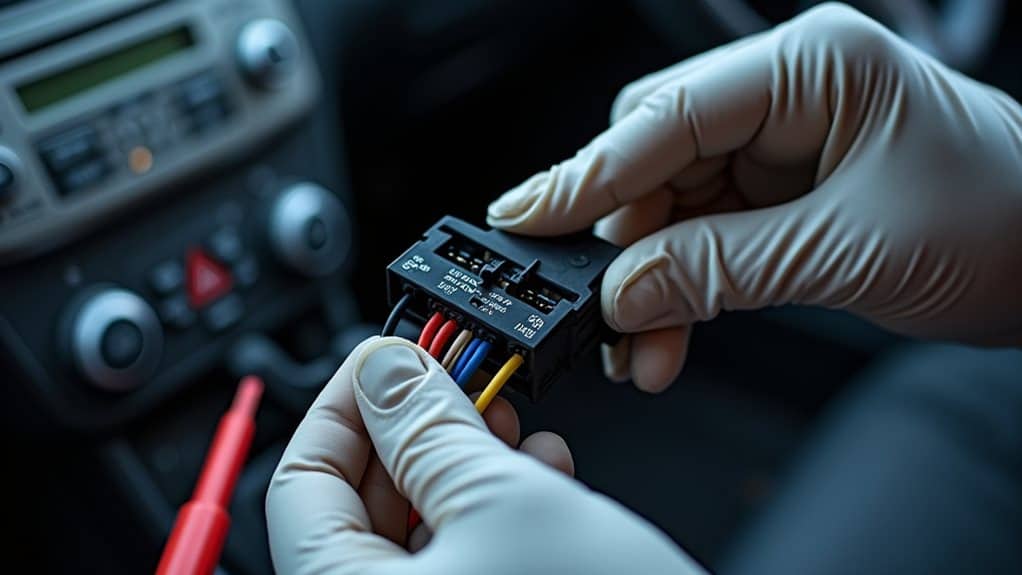You can reset a Nissan airbag (SRS) light by first taking safety steps: park, key out, disconnect the negative battery and wait 10–30 minutes to discharge capacitors. Visually inspect seatbelt buckles, occupant classification mat, clock spring, wiring looms and airbag module connectors for damage or corrosion, then reconnect battery. Try a timed ignition-cycle clear or use an OBD-II SRS scanner to read and erase DTCs; if the light returns, follow diagnostics or repairs. Continue for full procedures and model specifics.
Quick Tips
- Safely disconnect the negative battery terminal and wait 10–30 minutes to allow SRS capacitors to discharge before any airbag work.
- Use an OBD-II/SRS-capable scan tool to read and record airbag DTCs, then clear codes per tool instructions.
- Inspect connectors, wiring, seatbelt buckle and OCS mat for damage, corrosion, or loose pins before attempting a reset.
- If no scan tool, perform the model-specific ignition ON/OFF cycle reset sequence, timing OFF intervals around 5 seconds and repeat up to three times.
- If the SRS light returns or codes persist, replace faulty sensors/modules and have a professional reprogram or recalibrate components.
What Causes the Airbag Light to Turn On in Nissan Vehicles

When the airbag light comes on in your Nissan, it’s signaling that the supplemental restraint system has detected a fault and needs attention; common causes include faulty sensors, damaged wiring or connectors, problems with the seat Occupant Classification System (OCS), faults in the airbag control module, and electrical or battery issues. Check sensors, wiring, OCS calibration, the control module, and battery voltage for faults. A common method to attempt a reset without a scanner involves a timed ignition on/off sequence that uses the light’s initial blink-off as the trigger to power down, repeated across three cycles three cycles. Regular inspection and professional diagnostics are important because persistent warnings can indicate broader electrical system or EVAP-related faults that may not clear with a simple reset.
Safety Precautions Before Attempting a Reset
Knowing what can trigger the airbag light helps you pinpoint faults, but you should take several safety steps before attempting any reset.
Park on level ground, engage the parking brake, remove keys, and disconnect the negative battery terminal, waiting 10–15 minutes. Also inspect the battery terminals and cables for looseness or corrosion to prevent related electrical issues.
Ground yourself to avoid static, wear protective gear, inspect wiring visually, and don’t tamper with airbags without proper training—seek a technician if unsure. Modern vehicles often require professional diagnostics to identify specific SRS faults.
Tools and Materials You May Need

Before you start any work on the airbag system, assemble the right tools and materials so you can diagnose and fix issues safely and efficiently; having the proper equipment reduces guesswork and prevents unnecessary component damage.
You’ll need an OBD-II or SRS code reader, multimeter, ratchet/screwdrivers, insulation tape, anti-static gloves, torque wrench, replacement modules or fuses, wiring diagrams, diagnostic software updates, and safety gear.
Also verify related circuits and protective devices such as the neutral safety fuse or wiring to ensure proper power supply before resetting the airbag light.
Checking Seatbelt Buckle and Occupancy Sensors
If a lit airbag warning points to the front seats, start by inspecting the seatbelt buckle and passenger occupancy sensors, since these components directly affect deployment logic and often cause warning lights when they fail; you’ll be checking both electrical and mechanical conditions.
Visually inspect connectors and wiring, test buckle sensor continuity, verify occupancy mat seating and recalibrate after seat work, then run diagnostic codes.
Also perform a multimeter continuity check on wiring and connectors to confirm proper circuits and detect any open circuit faults that could trigger the airbag light.
Inspecting Airbag Module Connectors and Wiring

When inspecting the airbag module connectors and wiring, start by visually confirming that every connector is fully seated and the locking tabs are engaged, because loose or partially connected plugs are a common cause of airbag faults; look closely for cracked or melted plastic, bent or missing pins, and any corrosion on terminals that can increase resistance and interrupt the circuit.
Then check wiring looms for cuts, abrasion, previous repairs, proper routing, and test continuity and resistance with a multimeter, including clock spring circuits, replacing damaged connectors or wires per manufacturer guidance.
Battery Disconnect: Proper Steps and Wait Times
Start by turning off the ignition, removing the key, and making sure no accessories are powered, then put on protective gloves and eyewear before you touch the battery; this reduces the risk of sparks and keeps you safe from acid exposure.
Disconnect the negative terminal first with proper tools, isolate both terminals, then wait 10–30 minutes for the airbag module to discharge fully before reconnecting.
Manual Ignition Cycle Reset Procedure (No Scan Tool)

Start by cycling the ignition from off to on (not to start), and watch the airbag light: it will glow solid for about seven seconds then begin blinking, and you must turn the key off immediately as the blinking starts to capture the correct timing.
After counting slowly to five with the key off, repeat that on–off five-second sequence two more times for a total of three cycles, because the system only enters diagnostic mode after the final slow-blink pattern appears.
Keep all doors closed and the engine off during the process, and if the light doesn’t stop blinking after completing the cycles you can repeat the routine up to three times before seeking a professional scan-tool check.
Ignition ON/OFF Sequence
Although you won’t need a scan tool for this manual method, you’ll follow a precise ignition ON/OFF sequence to put the airbag system into its diagnostic reset mode, and you should perform each step exactly to avoid confusing the module.
Turn key ON, watch the SRS light, turn OFF as it extinguishes, wait ~5 seconds, repeat three cycles, then allow diagnostic blinking before a final OFF/ON.
Diagnostic Blink Timing
When you turn the key to ON the airbag (SRS) light will stay steady for a few seconds as the control unit powers up and runs its self-test, then it will momentarily go out and immediately begin the first rapid flash that marks the start of the diagnostic timing window; you must turn the key OFF the instant that initial flash appears and count five seconds before repeating the cycle, because that precise timing tells the module you’re initiating the manual reset sequence.
After three correct cycles, turn ON to observe slower diagnostic blinks for about 30 seconds, then cycle power to complete the reset; mistimed attempts will fail.
Alternative Timing Methods for Different Nissan Models
You’ll need to adjust timing when using ignition-cycle resets because cycle timing differences across Nissan models change the exact ON–OFF rhythm required to enter diagnostic mode.
Watch the airbag light’s slow-blink durations closely—some models use a short, steady slow blink to signal entry while others hold a longer blink before you should switch the key, and counting seconds (5, 10, or even 30) is often necessary.
If a model-specific wait is required, follow the documented interval and confirm success by observing the light change from steady to slow flash, then to off, or use a scan tool for verification when the pattern doesn’t match known sequences.
Cycle Timing Differences
Because Nissan changed SRS hardware and software over the years, the exact timing you use to cycle the ignition for an airbag-light reset can vary considerably by model, so you’ll need to adapt procedures rather than rely on a single universal method.
Count precise delays (about 5 seconds) between off/on cycles, repeat typical three-cycle patterns, and allow longer waits or battery-disconnect intervals for newer modules.
Slow-Blink Durations
Slow-blink durations serve as a key diagnostic signal on many Nissan models, and you should learn how their timing maps to stored SRS fault codes so you can read the system without a scanner.
Count slow blinks as the “tens” digit, note ~1-second intervals on many models, and record longer or shorter pacing per vehicle; this maps to SRS codes for troubleshooting.
Model-Specific Waits
When resetting SRS lights, different Nissan models use slightly different wait times and sequence cues, so you’ll need to follow the model-specific timing rather than relying on a single universal routine.
For Altima, watch for flash-to-flash then OFF five seconds, repeat three times; NV200 may need longer waits; 2007 needs a 30-second slow blink pause; battery disconnect uses 10–15 minutes.
Using a Scan Tool to Read and Clear Airbag Codes
Start by locating the vehicle’s OBD-II port—usually under the driver’s side dash—and plug in an OBD-II compatible scan tool that supports Nissan SRS (airbag) diagnostics, then turn the ignition to ON (engine off) so the tool powers up and can initialize communication with the airbag module.
Read SRS DTCs, record codes, note active versus historic faults, then use the tool’s erase function to clear codes, verify deletion, and restart to confirm the warning light status.
When a Reset Fails: Diagnostic and Repair Options

If clearing airbag codes with a compatible scan tool doesn’t extinguish the SRS warning, you’ll need a systematic diagnostic approach to find the underlying fault and repair it so resets will stick.
Inspect sensors, wiring and connectors for damage or corrosion; test seat and frame sensors, clock spring, and pretensioners. Replace faulty sensors or the SRS control module, and reprogram or recalibrate as required.
Verifying the System After a Successful Reset
Although you’ve completed the reset procedure, you should verify the system thoroughly to confirm the Supplemental Restraint System (SRS) is fully restored and safe to rely on.
Check that the airbag light briefly illuminates then goes out; scan with an OBD2 tool to clear/read codes; perform ignition cycles and a short test drive; inspect belts, connectors, and seat sensors; consult a technician if faults recur.
Wrapping Up
You’ve learned why the Nissan airbag light comes on and how to approach a reset safely; before you act, disconnect the battery and follow manufacturer timing procedures to avoid accidental deployment. Check seatbelt and occupancy sensors first, then inspect connectors and wiring for damage, and use a compatible scan tool to read and clear codes; if the light won’t reset, seek diagnostic testing and professional repair. Finally, confirm system readiness by verifying codes are cleared and the light stays off.

